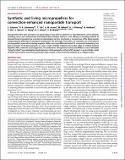Synthetic and living micropropellers for convection-enhanced nanoparticle transport
Author(s)
Schuerle, S; Soleimany, Ava; Yeh, Tiffany; Anand, G. M.; Häberli, M; Fleming, Heather; Mirkhani, N; Qiu, F; Hauert, S; Wang, X; Nelson, BJ; Bhatia, Saurav; ... Show more Show less
DownloadPublished version (827.4Kb)
Publisher with Creative Commons License
Publisher with Creative Commons License
Creative Commons Attribution
Terms of use
Metadata
Show full item recordAbstract
Nanoparticles (NPs) have emerged as an advantageous drug delivery platform for the treatment of various ailments including cancer and cardiovascular and inflammatory diseases. However, their efficacy in shuttling materials to diseased tissue is hampered by a number of physiological barriers. One hurdle is transport out of the blood vessels, compounded by difficulties in subsequent penetration into the target tissue. Here, we report the use of two distinct micropropellers powered by rotating magnetic fields to increase diffusion-limited NP transport by enhancing local fluid convection. In the first approach, we used a single synthetic magnetic microrobot called an artificial bacterial flagellum(ABF), and in the second approach,we used swarms of magnetotactic bacteria (MTB) to create a directable "living ferrofluid" by exploiting ferrohydrodynamics. Both approaches enhance NP transport in a microfluidicmodel of blood extravasation and tissue penetration that consists of microchannels bordered by a collagen matrix.
Date issued
2019-04Department
Massachusetts Institute of Technology. Institute for Medical Engineering & Science; Massachusetts Institute of Technology. Research Laboratory of Electronics; Massachusetts Institute of Technology. Department of Electrical Engineering and Computer Science; Koch Institute for Integrative Cancer Research at MITJournal
Science Advances
Publisher
American Association for the Advancement of Science (AAAS)
Citation
Schuerle, S. et al. "Synthetic and living micropropellers for convection-enhanced nanoparticle transport." Science Advances 5, 4 (April 2019): eaav4803 © 2019 The Authors
Version: Final published version
ISSN
2375-2548